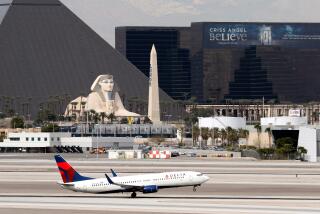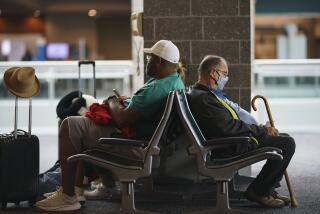Flier frostbite
- Share via
Question: I traveled to the United States from Frankfurt, Germany, in May. I’ve been on the same flight before, so I knew to be prepared with a sweater. Now, I’m sensitive to the cold, so this time I also brought along a thermometer. It was 51 degrees Fahrenheit (although sometimes it inched up to 53). Many of the passengers were wearing heavy jackets, and people were coughing. Why would they keep it so cold?
Sophia Lee
Los Angeles
Answer: One possible answer: because they don’t know it’s that cold.
Remember that, as a passenger, you are in someone’s workplace, and it’s not yours.
Just as some restaurants tend to seem a little too cold, some aircraft cabins feel frosty because the people rushing to serve you are expending energy. You, on the other hand, are sitting there listening to Motown sounds of the ‘70s and you’re doing nothing but losing body heat and killing brain cells with bad music. So the flight attendants may not realize it’s uncomfortable.
Further, you may be less comfortable because of your own anatomy. One theory holds that people who live in cold climes develop stocky bodies that retain heat and that people who live in warm climes are lean and lanky so they can throw off heat and be cool.
This could explain why there are so many thin people in Southern California, although cosmetic surgery may also explain it.
So if you’re tall and skinny, you’re going to feel the cold. If you’re not used to cold weather -- there really is something to the theory of acclimation -- you’re also going to feel it. Still, 51 degrees is so cold that you’d think that seeing little puffs of breath would tip somebody off that it’s a tad on the chilly side.
Alas, the Federal Aviation Administration doesn’t regulate cabin temperature. But the American Society of Heating, Refrigerating and Air-Conditioning Engineers has developed a standard that addresses air quality, including temperature, in airliners.
Among its many suggestions: It should never be colder than 65 or hotter than 80 (or 85, if the in-flight entertainment system is on).
Adoption of the standard, unveiled in May, could take several years if the FAA launches the rule-making process, said Byron Jones, associate dean of research at the College of Engineering at Kansas State University in Manhattan and chairman of the committee that developed the plan.
Until then, you’re at the mercy of whoever is in charge of the thermostat -- just like at home. Your best defense is dressing in layers and taking a silk sleep sack (akin to a sleeping bag liner but in silk), which takes up little room and is easy to slip into. Also, don’t forget to turn off the overhead air valve, known as a “gasper.”
If you’re still cold, ask a flight attendant to warm it up. If you don’t get any satisfaction, sitting there seething may, in fact, raise your body temperature. And that’s some cold comfort.
--
Have a travel dilemma? Write to travel@ latimes.com.
More to Read
Sign up for The Wild
We’ll help you find the best places to hike, bike and run, as well as the perfect silent spots for meditation and yoga.
You may occasionally receive promotional content from the Los Angeles Times.







